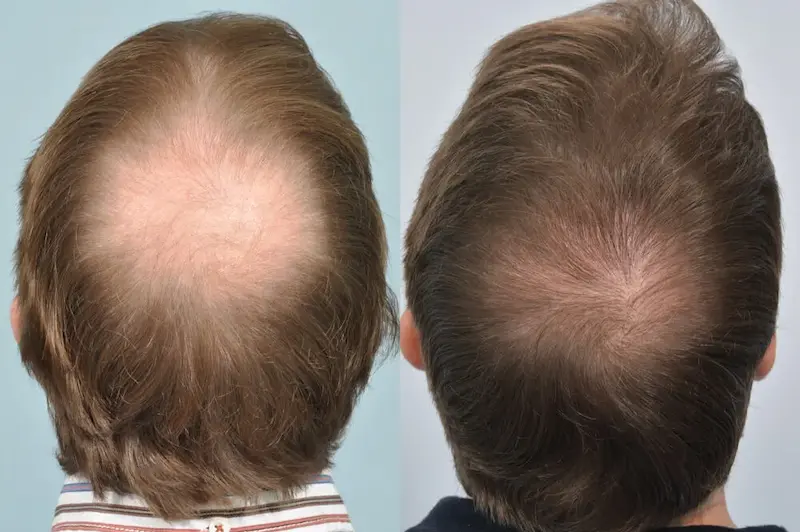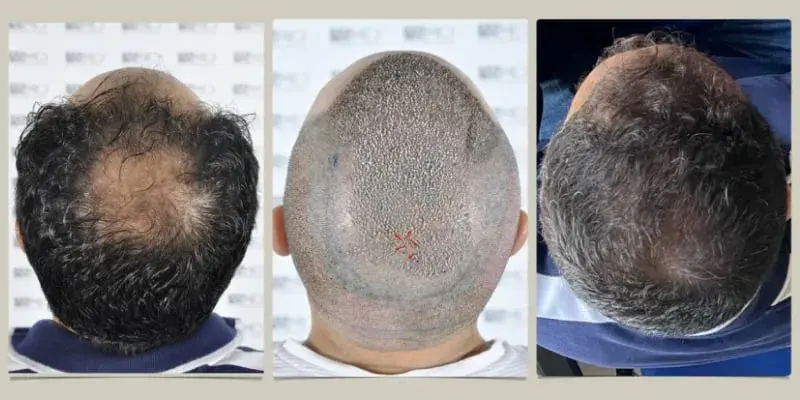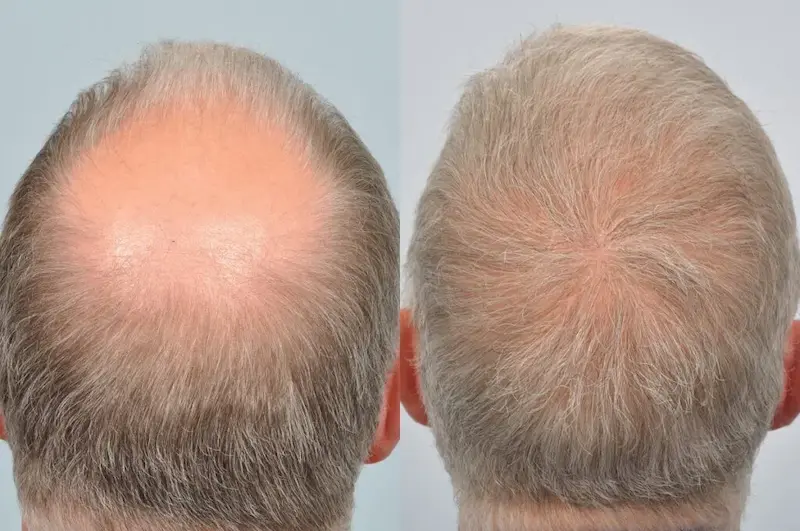Crown Hair Transplant – Mastering the Art of Crown Restoration
The Crown Hair Transplant is an effective solution for those experiencing thinning at the back of their scalp, commonly known as the crown area. Known for its unique challenges due to the direction and density of hair growth, specialized techniques like Follicular Unit Extraction (FUE) and Direct Hair Implantation (DHI) are often employed. The cost is influenced by factors such as the extent of the area and chosen method. Achieving optimal results involves selecting the right procedure, understanding post-operative care, and integrating maintenance tips to ensure long-term success.
Table of Contents
Why Focus on the Crown Area?
The “crown” or “vertex” region of the scalp is notorious for its susceptibility to hair thinning and baldness, particularly in men with male pattern baldness (androgenetic alopecia). However, women can also experience thinning in this area, albeit in a more diffuse pattern. There are several reasons why the crown attracts special focus in hair restoration discussions:
- Visibility and Angles: The top of the head is often visible to others, especially for people taller than you or when you’re seated. This exposure can highlight hair loss more prominently.
- Hair Growth Pattern: The crown typically features a distinctive whorl or spiral growth pattern, which can complicate the crown hair transplant process. Re-creating this natural swirl is vital for realistic results.
- Psychological Impact: Thinning at the crown can make individuals feel older or self-conscious. Restoring lost hair in this region often provides a significant confidence boost.
- Natural Progression of Hair Loss: In many cases of androgenetic alopecia, the hairline recedes first, followed by the crown. Alternatively, the crown can begin thinning while the front hairline remains relatively intact. Each pattern demands a specialized surgical plan.
Because the crown’s hair growth direction and swirl pattern differ from the frontal scalp, experienced surgeons must take a methodical approach to ensure transplanted follicles align correctly. A well-executed crown hair restoration not only fills in the balding area but also maintains the scalp’s natural look.
Understanding Hair Loss Patterns in the Crown
Hair loss in the crown typically progresses in one of two ways:
- Circular Expansion: A small bald spot in the center of the crown gradually expands outward, creating a larger, circular region of thinning or complete baldness.
- Diffuse Thinning: Some individuals experience more uniform hair thinning in the vertex region. While less dramatic initially, this thinning can become more noticeable over time as the overall hair volume decreases.
The “Black Hole Effect”
The crown region can appear as a “black hole” in photos or overhead lighting. Due to the angle and lighting, even moderate thinning can appear more severe than it is. This effect leads many individuals to seek solutions like topical sprays, concealers, or advanced crown hair thinning solutions—including transplants—to maintain a consistently dense look.
Matching Growth Patterns
One critical aspect of a crown hair transplant is matching the spiral whorl (or sometimes two or more whorls) that is unique to each individual’s scalp. Skilled surgeons place grafts in a radial pattern, mimicking the natural direction. If done improperly, the hair can grow in conflicting directions, resulting in an unnatural appearance.

Costs and Considerations for Crown Hair Transplants
Like any elective medical procedure, understanding the financial aspect of a Crown Hair Transplant is crucial. Multiple variables influence the price, such as the severity of your hair loss, the type of technique used, and the clinic’s expertise. While some individuals can manage with smaller sessions, others may require extensive grafting.
Detailed Breakdown of Procedure Expenses
- Consultation and Assessment
Many clinics offer an initial consultation for free, but some charge a nominal fee—often applied toward the procedure if you decide to proceed. This step includes scalp analysis, hair loss measurement, and discussions about your medical history. - Surgical Technique
The cost often differs between FUE (Follicular Unit Extraction) and FUT (Follicular Unit Transplantation). While FUE is typically more expensive due to the time-intensive nature of harvesting individual follicles, it boasts faster recovery times and no linear scar. DHI (Direct Hair Implantation) can also be priced at a premium because of the specialized tools and expertise needed. - Number of Grafts
A large portion of the expense stems from the total grafts required. Crown areas often demand a high number of grafts to achieve adequate coverage, sometimes more than a hairline transplant. Clinics commonly quote prices on a per-graft basis. For instance, if each graft costs $4 and you need 2,000 grafts, the total would be $8,000. Discounts might apply for larger sessions. - Anesthesia and Facility Fees
While some surgeons fold these costs into an all-inclusive price, others itemize them. The quality and comfort level of the facility, combined with local anesthesia or sedation options, can marginally affect costs. - Post-Operative Medication and Follow-Up
Antibiotics, anti-inflammatory medications, and follow-up consultations can add to the overall budget. Some clinics bundle these into the total, while others charge separately.
Comparing Prices Across Clinics and Locations
- Geographic Differences: Costs vary globally. Clinics in countries like Turkey, India, and parts of Eastern Europe often charge less due to lower overhead costs, yet many of them maintain high standards. In contrast, procedures in the U.S., Canada, or Western Europe usually come at a premium.
- Reputation and Experience: Renowned clinics with a history of successful hair transplant reviews and specialized surgeons may charge more, but patients often justify the premium for expertise and reliable outcomes.
- Package Deals: Many clinics cater to medical tourism by offering package deals that include accommodation, local transport, and personal care, making the overall experience more convenient, though not always cheaper.
Influencing Factors on Transplant Costs
- Extent of Baldness: Individuals with advanced hair loss require more grafts and possibly multiple sessions, increasing total costs.
- Hair Characteristics: Thicker or curly hair often provides better coverage, potentially reducing the number of grafts needed. Alternatively, fine or straight hair might necessitate more grafts for the same coverage.
- Surgeon’s Skill Level: Surgeons who specialize in crown hair transplant procedures with proven track records typically command higher fees.
- Additional Treatments: Some clinics suggest adjunct therapies like Platelet-Rich Plasma (PRP) injections or Low-Level Laser Therapy (LLLT) to expedite healing and enhance graft survival, each adding to total expenditures.
When planning a crown transplant, remember to weigh costs against the potential benefits of improved self-esteem and quality of life. Budget realistically for the entire process, ensuring you select a reputable clinic rather than opting for the cheapest option—quality often correlates with more natural, enduring outcomes.
Techniques for Restoring Hair in the Crown Region
Several crown hair restoration techniques exist, each offering unique advantages and considerations. Patients typically explore FUE, FUT, and DHI, although other methods (such as robotic-assisted transplants) also exist.
Distinguishing FUE from Other Methods for Crown Area
- Follicular Unit Extraction (FUE)
- Extraction: Individual follicles are harvested from the donor area (usually the back or sides of the scalp).
- Benefits: Minimally invasive, produces tiny circular scars rather than a single linear scar, and typically faster healing time.
- Suitability: Highly favored for crown hair transplant due to the precision needed for placing grafts in the swirling pattern.
- Challenges: More time-consuming than FUT, potentially leading to higher costs.
- Follicular Unit Transplantation (FUT)
- Extraction: A strip of scalp is removed from the donor region, and then individual follicles are dissected under a microscope.
- Benefits: Usually quicker extraction process and potentially less expensive since a large number of grafts can be harvested in one session.
- Drawbacks: Leaves a linear scar; longer downtime may be necessary for healing.
- Robotic FUE
- Extraction: Uses computer-assisted technology to identify and extract the best donor follicles.
- Benefits: Increased precision and consistency, potentially reducing human error.
- Drawbacks: Not all clinics offer robotic systems, and it can be more costly.
Evaluating DHI Effectiveness in Crown Transplants
Direct Hair Implantation (DHI) is a variation of FUE where surgeons utilize a specialized tool called a Choi Implanter Pen to implant grafts directly into the recipient site without creating incisions beforehand.
- Efficiency: By bypassing the separate step of creating recipient incisions, DHI might reduce the time grafts spend outside the body, potentially improving survival rates.
- Precision: Surgeons can control the angle, direction, and depth of each implanted follicle, essential for replicating the natural swirl in the crown area.
- Cost and Expertise: Since DHI demands advanced training and specialized instruments, it typically costs more than standard FUE or FUT.
- Optimal Candidate: Patients with mild-to-moderate crown thinning who desire meticulous placement often choose DHI, though it can work effectively for larger areas as well.
Ultimately, the best technique for hair transplant for the crown area depends on factors such as your hair’s characteristics, budget, and surgeon’s recommendation. Conduct thorough research and consult with a qualified specialist before selecting an approach.

Reviews of Clinics Performing Crown Hair Transplants
Choosing the right clinic is one of the most vital steps in achieving successful transplant outcomes. Reading hair transplant reviews and patient testimonials can help you gauge real-world experiences, while also offering insight into cost, patient care, and long-term satisfaction.
Top Clinics Specializing in Crown Transplants
- Internationally Renowned Institutes: Some well-known U.S. centers, like those in New York or Los Angeles, have surgeons with decades of experience and access to cutting-edge technology. Many clinics in Europe and Australia also boast strong reputations.
- Medical Tourism Hubs: Countries like Turkey have emerged as major destinations for hair restoration. The blend of experienced surgeons, competitive prices, and comprehensive patient packages has elevated Turkey’s global standing in the industry.
- Boutique Clinics: Smaller clinics sometimes provide highly personalized care and a surgeon-focused approach, though their prices or waiting lists may be higher.
When evaluating clinics, consider their expertise specifically in crown transplants—while many surgeons can handle hairlines effectively, the crown’s swirling growth pattern requires an additional layer of finesse.
Factors to Consider When Choosing a Clinic
- Surgeon’s Credentials: Look for board-certified specialists with a significant portfolio of crown transplant cases.
- Before-and-After Photos: These visuals can reveal how skilled the clinic is at replicating the spiral pattern in the crown.
- Patient Reviews and Ratings: While success stories are uplifting, negative reviews can highlight potential pitfalls or areas for caution.
- Technology and Technique: Confirm if the clinic offers advanced options like DHI or robotic FUE if you’re specifically interested in these approaches.
- Consultation Quality: A thorough assessment and honest discussion about expectations, graft counts, and potential risks reflect a clinic’s commitment to patient satisfaction.
Investing time in research upfront can prevent dissatisfaction and complications later. An in-person or virtual consultation offers valuable insights into a clinic’s communication style, professionalism, and approach to customized treatment plans.
Process of Hair Growth After a Crown Transplant
Understanding the timeline for hair growth helps manage expectations. The journey from initial surgery day to seeing significant regrowth can feel long, but patience is crucial.
Stages of Regrowth in the Crown Area
- Initial Healing (Weeks 1–2)
- You may experience mild swelling, redness, and scabbing around the transplant sites. Avoid picking at scabs, as that can disrupt newly placed grafts.
- The donor area (where follicles were extracted) also requires care to prevent infection and excessive scarring.
- Shedding Phase (Weeks 2–8)
- Transplanted hairs often shed during this period, which can be alarming. This phenomenon, known as “shock loss,” is normal—only the hair shafts fall out, not the follicles.
- Ensure adequate rest, nutrition, and follow any clinic-prescribed post-op guidelines to minimize stress on the scalp.
- Dormant Phase (Months 2–4)
- After shedding, transplanted follicles enter a dormant phase. You might not see immediate regrowth, which can be frustrating. Patience is key here.
- Some patients notice early signs of regrowth (fine, baby-like hair), but most see minimal changes until around the three- or four-month mark.
- Active Growth (Months 4–9)
- Newly transplanted follicles begin robust growth, thickening steadily. The crown area tends to lag slightly behind the front hairline in visible change, given that the swirl often needs more time to achieve uniform coverage.
- At around six months post-op, you can typically see noticeable improvements.
- Maturation (Months 9–12 and Beyond)
- Hairs continue to thicken and mature in texture. By the 12-month point, most patients have a good sense of their final outcome, though subtle refinements can occur well into the 18-month range.
Monitoring Progress and Outcomes
- Regular Check-Ins: Clinics often schedule follow-up visits to track growth, address any complications, and provide guidance on maintenance.
- Photographic Documentation: Taking monthly pictures under consistent lighting can help you objectively assess progress.
- Lifestyle Factors: Proper nutrition, reduced stress, and good scalp care can accelerate regrowth. Avoid smoking, excessive alcohol, and harsh chemical treatments during the healing phase.
Most individuals find that long-term results for crown transplants justify the waiting period, especially when working with an experienced surgeon. Consistency with post-transplant care significantly impacts how evenly and robustly the transplanted hairs grow.
Addressing Challenges in Crown Hair Restoration
Transplanting hair to the crown is uniquely challenging due to the swirl pattern and the often-larger balding surface compared to a frontal or hairline procedure. Understanding these nuances prepares patients for realistic expectations.
Tackling Common Problems and Solutions
- Insufficient Donor Hair
- Problem: Individuals with extensive hair loss might not have enough healthy donor follicles on the back or sides of their scalp to cover a large crown area.
- Solution: Some opt to transplant the frontal region first (hairline) and then address the crown in stages. Alternative donor areas (like the chest or beard) might be considered in advanced cases, though these hairs can differ in texture or growth pattern.
- Graft Survival Rate
- Problem: If grafts are mishandled or placed inefficiently, survival rates dip, leading to suboptimal coverage.
- Solution: Seek clinics with well-trained staff and advanced technology. Proper post-op care—including gentle shampooing, avoiding direct trauma to the grafts, and using recommended topical medications—significantly boosts graft viability.
- Hair Direction and Angle
- Problem: The crown swirl requires precision in graft placement. Even slight misalignment can look unnatural once hair grows out.
- Solution: Experienced surgeons meticulously plant grafts following your unique swirl pattern, ensuring they angle each follicle appropriately.
- Slower Perceived Growth
- Problem: The crown can take longer to fill in or appear dense compared to the hairline. This can be discouraging.
- Solution: Patience and long-term planning are vital. Surgeons can evaluate if multiple sessions are needed or if adjunct therapies (like PRP) can be beneficial.
Strategies to Enhance Transplant Success
- Pre-Transplant Preparations: Optimize scalp health by avoiding harsh chemicals, ensuring nutritional adequacy (biotin, vitamins, minerals), and addressing underlying conditions like seborrheic dermatitis.
- Follow Medical Advice: Adhering to medication schedules (e.g., minoxidil or finasteride) may preserve existing hair and support new growth.
- Multiple Sessions: Large or advanced crown baldness sometimes necessitates more than one session to achieve the desired density. Spread-out procedures reduce stress on the donor area and allow assessment of the initial transplant’s effectiveness.
- Realistic Goal-Setting: Work with your surgeon to set expectations based on your donor supply, hair characteristics, and budget constraints. Some patients prioritize the hairline if donor supply is limited, while others focus entirely on the crown.
By anticipating potential hurdles and adhering to professional guidance, you can significantly improve the likelihood of a satisfactory outcome in your Crown Hair Transplant journey.
Hair Maintenance Post-Transplant
Long-term success doesn’t end once the grafts are in place. Proper hair and scalp care post-surgery is essential, not just in the immediate recovery phase but for ongoing health and vitality.
Recommended Care Routines
- Gentle Cleansing:
- Immediate Phase: Within the first two weeks, many clinics advise gentle rinsing without harsh scrubbing. Specialty shampoos or saline sprays help keep the scalp clean.
- Long-Term: Use mild, sulfate-free shampoos and avoid overly hot water to prevent scalp irritation.
- Avoiding Trauma:
- Physical Activity: Postpone strenuous exercise, heavy lifting, or contact sports for at least two weeks to avoid dislodging grafts or increasing scalp blood pressure excessively.
- Sleeping Position: Surgeons may recommend keeping your head slightly elevated for several days to reduce swelling.
- Sun Protection:
- UV Damage: Prolonged sun exposure can harm sensitive scalp tissue and newly transplanted follicles. Wear a hat or use sunscreen formulated for the scalp when venturing outdoors.
- Long-Term: Chronic UV exposure can cause hair shaft damage and scalp dryness, impacting overall hair quality.
- Medication and Topicals:
- Antibiotics and Anti-Inflammatories: Short-term use post-procedure prevents infection and reduces swelling.
- Minoxidil/Finasteride: If prescribed, these can slow further hair loss and support new growth. Patients must be consistent, as stopping abruptly might reverse any benefits.
- Periodic Check-Ups:
- Follow-Up Appointments: Clinics often schedule visits to monitor the healing process and address concerns.
- Ongoing Assessments: If additional sessions are needed, these check-ups provide clarity on graft survival, scarring, or hair quality.
Products That Support Healthy Hair Growth
- Shampoos and Conditioners: Look for products containing ketoconazole, saw palmetto, or biotin, which may support scalp health and potentially reduce DHT impact.
- Topical Serums: Ingredients like caffeine, rosemary oil, or peptides might stimulate blood flow and strengthen hair follicles, though results vary.
- Nutritional Supplements: Vitamins such as D, B-complex, and minerals like zinc or iron can fortify hair internally. However, consult a physician before starting new supplements.
- Laser Hair Growth Devices: At-home low-level laser therapy caps or combs aim to invigorate follicles, but their efficacy can differ from person to person.
Post-transplant maintenance combines consistent scalp care, protective measures against external stressors (e.g., UV, physical trauma), and a healthy lifestyle that supports overall well-being. By giving transplanted hair the best possible environment to flourish, you enhance your return on investment and maintain a natural look.
Frequently Asked Questions
How does a crown hair transplant differ from a hairline transplant?
A crown hair transplant focuses on the back portion of the scalp (the vertex or crown), which often features a distinctive swirl or whorl pattern. This area usually demands a higher number of grafts to achieve sufficient coverage because:
• The crown can have a large surface area to fill.
• Follicles must be placed in a radial or spiral arrangement to mimic the natural growth pattern.
In contrast, a hairline transplant addresses the front edge of the scalp. The primary focus in hairline procedures is crafting a natural and aesthetically pleasing frontal boundary, with meticulous single-hair grafts around the perimeter. Both procedures require surgical skill, but the crown’s unique directional growth can necessitate extra attention to angles and placement for realism.
What are the expected timelines for results with crown transplants?
Crown hair restoration generally follows these stages:
First 2 Weeks: Healing of incision sites, minimal scabs, and some redness.
Weeks 2–8: Shedding of transplanted hairs (the “shock loss” phase).
Months 2–4: Dormant period where the follicles settle; visible regrowth is minimal.
Months 4–9: Gradual regrowth becomes evident, with hairs thickening and improving in texture.
Months 9–12+: Hairs continue to mature; final results are often seen by 12–18 months.
The crown might take a slightly longer timeframe to appear dense because of its surface area and whorl pattern. Patience is key; results typically look increasingly natural over time.
How can one maximize the success of a crown hair transplant?
1. Choose the Right Surgeon: Look for a qualified professional experienced with challenges of crown hair transplant. Their expertise in angle, direction, and swirl reproduction is crucial.
2. Follow Post-Op Instructions: Proper cleaning, limited physical strain, and medication compliance help grafts remain stable and reduce complications.
3. Adopt a Healthy Lifestyle: Balanced nutrition, good hydration, reduced stress, and avoidance of smoking or excessive alcohol intake can bolster hair growth and quality.
4. Consider Adjunct Therapies: PRP treatments, low-level laser therapy, or prescription medications such as finasteride may preserve existing hair and aid in faster recovery or improved graft survival.
5. Manage Expectations: Crown restorations might require multiple sessions for optimal density. Realistic goals ensure satisfaction with incremental progress.



